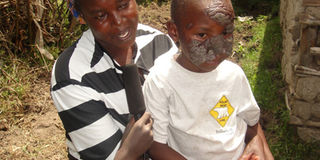Breaking News: At least 10 feared to have drowned in Makueni river
Sand fly bites leave family in agony

Ms Ann Wanjiku holds her seven-year old Francis Wakaba at their home in Biston in Njoro, Nakuru County. Wakaba is suffering from Cutaneous Leishmaniasis, a skin infection caused by a single-celled parasite that is transmitted through sand-fly bites. PHOTO/MORAA OBIRIA.
What you need to know:
- The protozoan skin disease known as Cutaneous Leishmaniasis is evident on the faces of Samwel Githaka Gichuki’s five children.
- But the most affected is his seven-year-old Francis Wakaba.
- Currently, the young Wakaba is undergoing treatment using injections some of which have to be made on his face.
- In Nakuru County the areas where the insect is found are in Gilgil Constituency.
A family in Biston area of Njoro Constituency in Nakuru is agonising over the effects of bites from the sand fly.
The protozoan skin disease known as Cutaneous Leishmaniasis is evident on the faces of Samwel Githaka Gichuki’s five children.
He has also not been spared as the mark on his lower arm shows traces of the disease.
His way of dealing with the disease was more painful as he had to use a panga to clear off the raised wounds on his skin.
But the most affected is his seven-year-old Francis Wakaba, a young, energetic boy whose social life has been disrupted by the raised lesions on his cheeks, nose, around the eye socket and on the forehead.
STARTED AS A PIMPLE
It all started as a pimple three years ago, just five days after Wakaba attended his first baby class lessons at a nearby school in Bagaria area within Njoro Constituency, where they lived.
“Then it slowly developed into outgrown scars of dry skin.
I do not know but I believe he was bitten by the fly while going or coming back from school,” said his father, Mr Gichuki during a visit to their rented mud-walled residence.
Distressed by the rapid development of the disease, they visited various hospitals to seek treatment but the prescriptions provided did not bring forth any promising changes.
Not even the healing power of the herbalists could bring magic to the disfigured face despite the fact that it had worked on his other four older children.
Now Wakaba is no longer attending to his studies as the look on his face scares away everybody around him.
Except for the youngest son who is three-and-half years old, his other four children including the eldest daughter, had fallen victims to the stings of the ruthless fly.
Unfortunately, the four, Minne Wanjiru (17), Joseph Gichuki (13), Moses Ngigi (12) and Godfrey Maina (9) are not going to school.
Their impoverished standard of living makes life more difficult for the family.
USED HERBS
“Before Wakaba got affected in 2010, my other children had the same problem but we used herbs on them and they got better.
However, it never worked for him (Wakaba),” said the mother, Anne Wanjiru.
Ms Wanjiru says her family was the only one in the village affected by the skin disease and due to stigma and alienation by the local community, they were forced to find refuge in the neighbouring Biston village.
The county government through the Governor Kinuthia Mbugua’s wife Lucia has however pledged to take care of the family’s medical expenses.
Currently, the young Wakaba is undergoing treatment using injections some of which have to be made on his face. The drug costs Sh15,000.
The rest are expected to begin medication as promised by Ms Mbugua.
SAND FLY HABITAT
The sand fly, according to the chief officer in-charge of health in the county Samwel Mwaura, inhabits the warmer bushes, forests, burrows, caves and even rubbish.
In Nakuru County the areas where the insect is found are in Gilgil Constituency which include Utut forest, Kampi Turkana, Ol-jorai and Gitare.
“The fly is so tiny that it can go through a mosquito net and it takes quite some time before the symptoms such as raised lesions manifest themselves,” Mr Mwaura said.
Seeking to curb its effect in Gilgil Constituency, he said they have erected trapping nets in the affected areas.
He however said they are currently mapping areas with high concentration of the fly.
“We have also involved Kenya Medical Research Institute in efforts to find a way of breaking the fly’s lifecycle,” he said.





